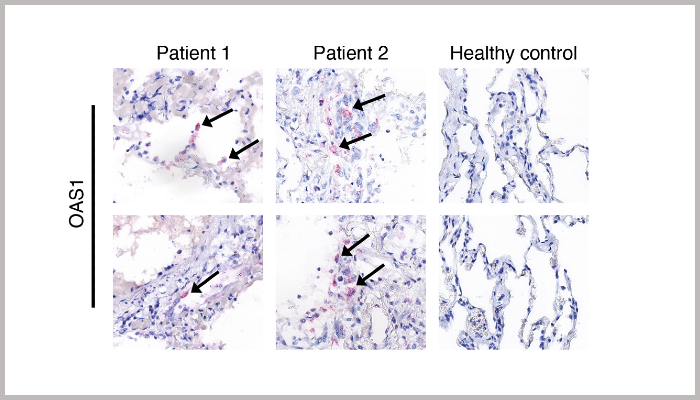Natural resistance to serious SARS-CoV-2 infection
Published: 30 September 2021
A new study by Institute Centre for Virus Research scientists has revealed key insights into the natural human antiviral defences against SARS-CoV-2, the virus that causes COVID-19.

A new study led by Institute Centre for Virus Research scientists has revealed key insights into the natural human antiviral defences against SARS-CoV-2, the virus that causes COVID-19.
The research, published in the journal Science, sheds new light on why some people are naturally more resistant to serious SARS-CoV-2 infection – and how, in the future, the coronavirus might overcome this resistance.
COVID-19 is spread from person to person after the virus, shed by an infected person, infects the cells of a new host. Once infected, our cells try to fight off the invading virus, and scientists already know that this works better in some people than others, making their experience of the disease less severe.
However, that anti-viral response, and its effect on the virus SARS-CoV-2, hasn’t been well-understood - until now.
In this study, the scientists reveal that some individuals have a version of a gene, called OAS1, that potently inhibits SARS-CoV-2.
It also showed that, while some people can express a more protective ‘prenylated’ version of the OAS1 gene, others express a version of this gene that does not detect SARS-CoV-2.
Coronaviruses hide inside cells and replicate inside vesicles coated with lipid (fat). Prenylation is the addition of a single molecule of lipid to a protein, and it’s this technical difference that allows prenylated OAS1 to ‘seek out’ the invading virus and ‘sound the alarm’.
The study found that, in hospitalised patients, expression of a prenylated version of this gene was associated with protection from severe COVID-19, which suggests this antiviral defence is a major component of a protective antiviral response, and is likely to have offered protection to many individuals during the course of the pandemic.
Furthermore, hospitalised COVID-19 patients with the ‘bad’ form of OAS1 experienced worse clinical outcomes compared to those who expressed the protective prenylated version of OAS1. Severe disease was significantly more frequent with ICU admission or death being approximately 1.6 times more likely in these patients.
The researchers also found that, approximately 55 million years ago, there was a removal of this protective gene in horseshoe bats – the presumed source of SARS-CoV-2 – meaning SARS-CoV-2 never required to adapt to evade this defence.
As the protective prenylated OAS1 gene is widespread in animals, the billions of people who lack this protective gene could make humans particularly vulnerable to the spill over of coronaviruses from horseshoe bats.
The CVR's Professor Sam Wilson said: “We know viruses adapt, and even SARS-CoV-2 has likely adapted to replicate in the animal reservoir(s) in which it circulates.
"Cross-species transmission to humans exposed the virus SARS-CoV-2 to a new repertoire of antiviral defences, some of which SARS-CoV-2 may not know how to evade.
“What our study shows us is that the coronavirus that caused the SARS outbreak in 2003 learned to evade prenylated OAS1.
"If SARS-CoV-2 variants learn the same trick, they could be substantially more pathogenic and transmissible in unvaccinated populations. This reinforces the need to continually monitor the emergence of new SARS-CoV-2 variants.”
![]() A Prenylated dsRNA Sensor Protects Against Severe COVID-19
A Prenylated dsRNA Sensor Protects Against Severe COVID-19
- Arthur Wickenhagen, Elena Sugrue, Spyros Lytras, Srikeerthana Kuchi, Marko Noerenberg, Matthew L. Turnbull, Colin Loney, Vanessa Herder, Jay Allan, Innes Jarmson, Natalia Cameron-Ruiz, Margus Varjak, Rute M. Pinto, Jeffrey Y. Lee, Louisa Iselin, Natasha Palmalux, Douglas G. Stewart, Simon Swingler, Edward J. D. Greenwood, Thomas W. M. Crozier, Quan Gu, Emma L. Davies, Sara Clohisey, Bo Wang, Fabio Trindade Maranhão Costa, Monique Freire Santana, Luiz Carlos de Lima Ferreira, Lee Murphy, Angie Fawkes, Alison Meynert, Graeme Grimes, ISARIC4C Investigators, Joao Luiz Da Silva Filho, Matthias Marti, Joseph Hughes, Richard J. Stanton, Eddie C. Y. Wang, Antonia Ho, Ilan Davis, Ruth F. Jarrett, Alfredo Castello, David L. Robertson, Malcolm G. Semple, Peter J. M. Openshaw, Massimo Palmarini, Paul J. Lehner, J. Kenneth Baillie, Suzannah J. Rihn, Sam J. Wilson*
-
SCIENCE. 28 Sep 2021. First Release. DOI: 10.1126/science.abj3624
Funding: The study was predominantly funded by the Medical Research Council, Wellcome, and UKRI.
Image legend: Figure 2: The ISG OAS1 initiates a block to SARS-CoV-2 replication. (F) Detection of OAS1 gene expression by RNAscope in FFPE lung tissue of deceased COVID-19 patients compared to healthy control lung tissue. Arrows indicate staining +ve cells.
Enquiries: ali.howard@glasgow.ac.uk or elizabeth.mcmeekin@glasgow.ac.uk / 0141 330 6557 or 0141 330 4831
First published: 30 September 2021

